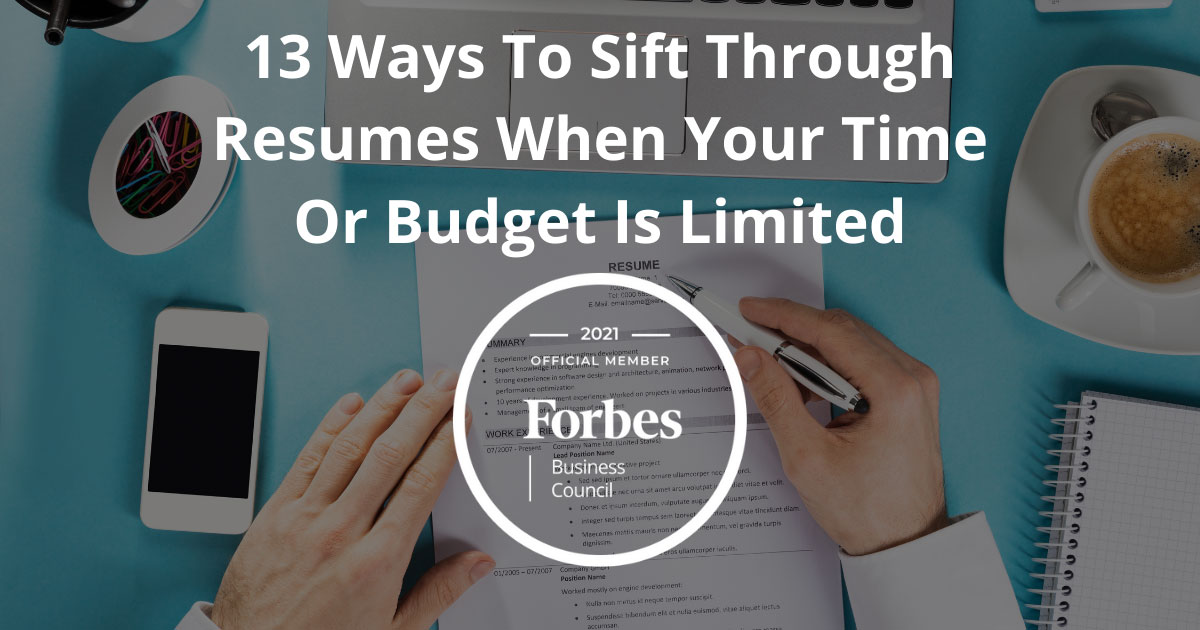The hiring process is one of the most challenging and time-consuming processes a manager or business owner can have to go through. It can be overwhelming to sift through dozens, or sometimes hundreds, of resumés looking for the perfect fit for your team. If you rush the process you could end up making a decision that’s going to waste time and money in the future. However, sometimes you just don’t have the time or budget to spare to take the process slowly.
Fortunately, there are ways to speed the process up. If you know where to look and how to develop little shortcuts, you can cut to the chase without spending too much time doing so. Here, 13 members of Forbes Business Council share the most creative tips and tricks they know for separating good resumés from bad ones when you’re running on a limited time or budget.
1. Make Quick Calls To Shortlisted Candidates
If you need to make a quick decision, pick up the phone. We recently looked at 200 resumés for an administrative position. After narrowing it down to four, I started calling them. I spend five minutes discussing their goals and any other top level information we need. By the end of it I’m able to tell them whether or not they will progress to the next step. – Taha Elraaid, Lamah Technologies
2. Determine Nonnegotiables
Before reviewing a resumés, make sure you have determined your must-haves/nonnegotiables and your nice-to-have list created. Be crystal clear on what you want and don’t want. This will save you time in the review process. – Todd Bavol, Integrity Staffing Solutions
3. Look For Achievements
Look for achievements in roles rather than responsibilities. In my experience, a great resume almost always speaks to the impact someone had in the role and the results they could deliver. – Pat Caldwell, FundApps
4. Rule Out Resumés With Generic Messaging
The first thing I do to quickly separate out bad resumés is to look for generic messaging. If an applicant’s resumés and cover letter appear generic, it’s likely they are sending the exact same document to multiple employers. Serious contenders carefully customize their resumés to emphasize those skills and qualifications that are most relevant to the job description you posted. – Penny Bauder, Green Kid Crafts, Inc
5. Look At Previous Employment Length
The first thing I look at is how long the person worked at each of their jobs. If there is not at least one job where they worked two or more years, or they have worked 4+ jobs for four months or less, then there’s a chance that they may not stay with us very long either (regardless of how great our workplace is). – Shan Bhagat, BKS Hotels
6. Learn What They Care About Outside Of Work
I always love to learn about what you care about outside of work. Do you give time to causes you care about? Are you an amateur photographer? Have you ever done standup? Everyone I’m considering probably has the basic skills I need. I want to know who you are, not just what you do. – Kelly O’Keefe, Brand Federation
7. Create A Simple Bot Using RPA
Create a simple bot using robotic process automation that can search through entire resumés packs using a combination of the keywords you want the bot to work with and let it throw out a keyword density/propensity match. This way, you get a quick shortlist of the profiles you’d really like to look at. – Saurabh Goenka, MindMap Digital
8. Focus On Referrals From Colleagues
When reviewing resumés, I have always focused first on those individuals referred from internal colleagues and other professionals. They go to the top. Then, I scan for two things: the tenure or duration of the candidate’s time in each position and the reputation of the firms and educational institutions on their resumés. Anybody with unstable employment doesn’t make the cut. – James Langabeer, Yellowstone Consulting
9. Check The Source Of The Resumé
Consider the source where the resume arrived from. If the resumés is from an employee that’s already in the company, there’s a higher likelihood that they will fit the culture and the team than others. – Adam Rudman, Apartments Near Me
10. Research Profiles On Social Platforms
Research their social media platforms like Facebook or LinkedIn. Platforms like LinkedIn can tell a lot about an applicant’s past experience and achievements. It will hardly take any time and applicants might write a few extra things in their resumés but social media never lies. We always start with their LinkedIn profile search and it makes our process of filtering faster. – Sanket Shah, InVideo Innovation Pte Ltd.
11. Look For Subjective, Unbacked Claims
I recommend looking out for subjective claims that are not backed up by facts, examples and career highlights. If an applicant doesn’t take the time to present themselves well on paper, it may be an indication of the effort they put into their work. – Muraly Srinarayanathas, Computek College
12. Focus On The Specifics
According to eye-tracking research, recruiters take about seven seconds to decide to continue reading a resume or toss it. When you have limited time or budget, review the summary and look for validation within the content of the professional experience. If the resumé seems too generic and offers no specifics, it’s time to toss. A plus is a resumé with a link to a personalized video or virtual sample. – Loubna Noureddin, Mind Market LLC
13. Give Them Specific Instructions
One easy tip is to give specific instructions to see if they will follow directions. Submit to X email; Put Y in the subject line; Attach Z. If those specifics aren’t followed, it’s likely that other directions won’t be either. That’s a quick pass in sorting through the pile of resumés. – Shannon Brooks, Shannon Brooks Consulting
This article was also published on Forbes.com

